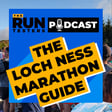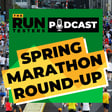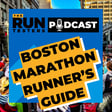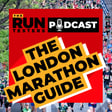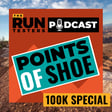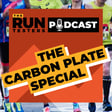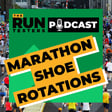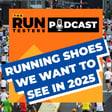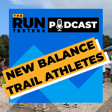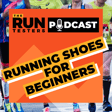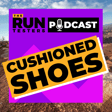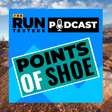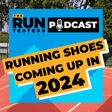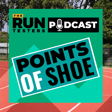Become a Creator today!Start creating today - Share your story with the world!
Start for free
00:00:00
00:00:01

Running Shoe Questions Answered: Points of Shoe Episode 6
In this series from The Run Testers, the team answers your running shoe and tech questions.
This week Tom and Nick talk about sizing down in race shoes, how to pick a running rotation and training for speed in-between marathons.
If you have a question about running shoes that you want us to answer on the pod, send us an email to team@theruntesters.com with "Points of Shoe" in the subject line.
Big thanks to Fear of Tigers for the killer intro music. You can listen to more of his stuff over at https://www.patreon.com/fearoftigers
Transcript
Introduction to Points of Shoe Podcast
00:00:01
Speaker
Hey, Tommy from The Run Testers, and welcome back to another episode of Points of Shoe, where we answer the questions that you've sent in on things to do with shoes, watches, and running in general. This week, we've got loads of questions, including if you need to size down in race shoes, how to build a running rotation, and if you should be focusing on 5K distance in between your marathons. Right, let's dive in and do the podcast.
Choosing the Right Track Session Shoe
00:00:34
Speaker
Right then, Chief, what's going down? Hey, not a lot. Not much has changed since we last spoke. Yeah, just bumbling on. How are you? Fine. Fine. Good. Still no doors. Still no doors, but who needs them?
00:00:49
Speaker
Don't need them. Don't need them. Don't need them. Like them, but don't need them. Yeah, they are useful sometimes, but maybe I'll get some at some point. We'll see. See if the mood takes me. Right. Shall we do some questions? Let's do it. Okay. Let's kick off with Vince. He says, what makes a good track session shoe and what are your current favorites? Well, it used to be a nice low profile.
00:01:13
Speaker
fast lightweight shoe. If I'm honest, I do my track session most weeks in a different shoe, depending on what we're having to review. I think any of the modern carbon shoes are pretty good track shoes, but I particularly like the Takumi Sen because it is a bit lower profile while still being comfortable enough. So if I'm doing a fast track session where if I'm targeting 5K races and my sessions, it's really fast reps, all out reps, so that Takumi's very good or even
00:01:38
Speaker
occasionally spikes, but very rarely spikes. I don't like spikes because it's just too much through the body. But if I'm in marathon training, I'll be doing long sessions on the track. I will just use a comfortable carbon shoe to manage I can run well again the next day. So probably not... Yeah, we're not traditionalist in terms of track shoes. Right, Tom? No. Well, I'm definitely not a traditional track runner.
00:01:58
Speaker
But I would say, I always use my carbon plate shoes for track, but there are some that I don't like using that just don't work very well for track. I think with the Takubis N10, the thing I like about that is that, especially if you're doing a very short, fast track session, it just feels very quick to just take off, very nice turning around the corners and everything like that, whereas some carbon plate shoes, the bigger ones, the ones that are really designed for marathons, I can feel like there's a bit too much shoe on my foot for this run, and there are some that I just prefer.
00:02:28
Speaker
using. Yeah, I wouldn't like to use like the Mizuno Wave Rebellion Pro 2 for a 400 metre rip track. I used it on the track actually for, well it was a 20 laps continuous thing, just changing pace each lap. But I was actually, I kind of for short reps,
00:02:43
Speaker
care about the shoe a lot less. So tomorrow I've got tractors from doing a mile, you know, easy, steady paint, not too fast. And then some fours, some threes and some twos and then another mile. And it's that kind of session. I was tempted to just go down in the Brooks ghost. Like it doesn't really matter. Cause just a pure interval of speed. Just totally, I don't want to be anything too heavy, but I have done like 400 meter reps and like the Adidas Adi star and stuff like that. Cause it's, um, I thought it was really short intervals. And I don't mind so much. I just like a light, I prefer a lightweight shoes. I would prefer something like to could be for sure, but it doesn't matter so much more.
00:03:13
Speaker
sessions I really care about shoes are the kind of long tempos, those kind of thing where I think, yeah, but I agree with you. There's some, some of the shoes on the track just don't feel so good for short reps. When you go down, you're going down the track, you're not, you're doing it alone on you. You're sort of running solo and doing your own session. Yeah. Or a mate. Yeah. Usually solo. So when I go down the track, I'm there with like 20 other people and it gets quite competitive. Like there's groups, you get, you're putting groups based on your speed and you get slightly harder workout based on that group.
00:03:43
Speaker
So when I go down, I actually do want to take my fastest possible shoe so I can keep up with the main groove and things. So I don't want to go for the ghost. I was going to hit my paces. I was tempted to do like a whole week of training. I really like a new ghost, but it's also just like, I've got quite a relaxed week this week. I used to do everything in the ghost, run a racer parker and see what happens. But yeah, I'd usually just use the carpentry I'm using and I find they're so good these days. Like if I'm going away and I know I'm going to have to go to the track at some point, any carpentry is just good because
00:04:11
Speaker
It's comfy, it's fast, but the Zacumi is a good track. It's one that stands out as a good track shoe. I will say the Under Armour of the Lost Elite 2, I'm not a particularly big fan of, but it is a good interval shoe and I've enjoyed using it for intervals. But again, that's not even light, but it just feels like a good interval shoe. It's nifty, yeah. It's quite responsive. Okay, here's one which I don't think
Why Aren't Fast Carbon Shoes Made in Wide Widths?
00:04:31
Speaker
we'll know the answer to. Why aren't there any fast carbon shoes made in wide-width fittings? Oh, I thought a new balance did do that.
00:04:38
Speaker
Now, did they, what would the S-elite be? I thought in general, they usually have a wide option. I don't know. I think in general, racing shoes are a bit more narrow, because people want lighter, more streamlined shoes, but I am surprised there's none in a wide fit. New balance, they're always... Brooks usually quite good for that kind of thing, I thought. And Hoka have a wide fit, a surprise.
00:04:58
Speaker
Yeah, I don't know where the company was, but I mean, I would say they're probably, it's just a commercial decision that they probably wouldn't sell that many of them. And it's expensive to produce shoes on a different last. So I think nearly all brands, I just don't think make a lot of money on carbon shoes, which is why they didn't make a fuss about them for a long time, because the actual volume of sale is so low compared to the Ghost, the Clifton, the Pegasus.
00:05:22
Speaker
Yeah, making different versions is probably, that's perhaps, yeah, you're right. That's the reason, isn't it? It's just not worth it. A business decision.
Favorite Racing Singlets
00:05:30
Speaker
Okay. What is your individual favourite brand of singlets based on comfort, fit and durability? Good question. The Saw Singlet, I think is my favourite in terms of just racing and the Tracksmith one, I think looks the nicest.
00:05:44
Speaker
Yeah, that's very good. I mean, I saw all the way for me for racing. I don't, I wouldn't use the saw if I wasn't racing because I just feel it's a little bit too, my body shape is not designed for saw vest. Body shaming here, Tom. Well, it's more, it's more, not so much the shape, more that I'm quite hairy. And what happens is it goes really low on my chest. So I just look, doesn't it? Yeah, I sized out and saw actually for that reason, because it did, it did hang a bit low on my chest. Yeah. I feel a bit awkward running around in a bright,
00:06:15
Speaker
best with on my chest air chain. But I would say, sort of definitely for racing, I'd say the best I ever race in. It's tracksmith, I do really like those for most of my runs. Saysky, I really like the best of Saysky. Yeah, Saysky's got a really good lightweight vest, it's much cheaper than those other two.
00:06:30
Speaker
which is good. Still not that cheap, so you can go Adidas and Nike have some good cheapy ones as well. I mean, I don't mind. Obviously, if you're a club runner in the UK and you've been a club runner for a while, you've all used scimitar vests and things like that, and I've used them for marathons, so you don't need to buy a very expensive vest.
00:06:47
Speaker
No, no, no. I've got plenty of vests that are like, you know, 20 pound Adidas ones, Nike ones, stuff like that. Absolutely fine. Just like, you know, no issues. New balance make good vests as well. Can new balances impact range in general? I think it's a really good value. Solid. Yeah. And also very good fitting for people like me who are a bit bulkier up top. It's quite comfortable. Yeah. I can wear a small probably in a new balance and it fits fine. I cannot wear a small in a in a saw.
00:07:15
Speaker
I'm a smaller than saw. Yeah, but yeah, but we were both I racings I mean Michael I bought a high bar I bought two of our club vests made by saw because I do think they're yeah, just really nice for the marathon in particular Yeah,
Bulkiness of Recovery Shoes
00:07:27
Speaker
really good. Okay, and the same person this is from Ryan He says having done 600 kilometers in the gel numbers 25 I've actually realized I would prefer a lower stack lighter shoe for my recovery runs. I am
00:07:41
Speaker
foot and 68 kilograms and they feel like cinder blocks. What are your thoughts on how bulky recovery shoe category is becoming? Well, you like bulk, but you don't like all the bulky ones. You like certain ones, right?
00:07:59
Speaker
I mean, there's a big difference between certain shoes. So you look at something like the Haka Bondi 8. That is a bulky shoe, which offers nothing back. It's just a bulky shoe. You'd love to bang on that shoe on this podcast. Yeah, it's just a perfect example of a bad bulky shoe. But if you, I mean, I'm not even an amazing fan of like the John number 25 or 26. I think they're fine. I think they're good. I think, I think there's a thing with, it's quite easy to go into a shop and look at the high sack shoe and go, that's great. That'll work for me. But if you look at something like the Tri 22,
00:08:27
Speaker
the geometry of that shoe and the style of it just doesn't work for my style of running. And I don't like the foam in it, even though it's one of my favorite foams in other shoes. I know there's a slightly different version of it. But I would say there are shoes that are coming out that are probably a little bit less so, like 1080p 13, which is
00:08:46
Speaker
not as bulky and max cushion to some of those big shoes, which I would wear for the same reasons. So yeah, we talked about when we talked about it about the future of running shoes and stuff. But one of the things that we hope to see in future is that some of these phones actually start getting a bit smaller, but still offer the same benefits you get from
00:09:06
Speaker
Yeah, I think I generally, and I'm six foot 68 kilos, so it might be relevant, and I don't like using a big shoe, but I think I have a lowest actually for recovery runs than I do for racing. I prefer a lowest, because I prefer just in general a lightweight shoe. And so what I like as my recovery shoe is more the daily training category these days. So the Velosti Nitro, the Ghost, and the Glycerin. And
00:09:29
Speaker
the previous version of the tribe they're probably about as cushioned as I'd ever go and I just don't like a shoe that's just too it's just a bit too much just not necessarily in size because I like the Nova Blast that's very high-stack shoe but it's just got a different feel to it just prefer I like it when I'm tired and I'm mooching along I like a lighter shoe if you want it's like just because it's just feels better you know I'm moving slowly but the lightness isn't helping me run fast it's just
00:09:53
Speaker
helping me run with my normal gait. There might be a rocker I also like on a shoe, so that obviously helps as well. So even the Mac, I like as a really nice recovery shoe. So yeah, if I was this, what's his name?
00:10:08
Speaker
Right. So in the exact same boat, I wouldn't use the Indial Nimbus. I would use the velocity. I'd use this new ghost is pretty nice or the glycerin I really like as well. And just like that dependable shoe with a good outsole that feels good at the end of runs. Doesn't get too squishy. Doesn't try to do anything too fancy and get too squishy as a result.
00:10:24
Speaker
Okay, and this one follows on a bit
Softest Recovery Shoe Recommendation
00:10:27
Speaker
from that. So this is from Ross. He says, recovery run shoes purely for absolute plodding when your legs are done from hard sessions. The softest, most squishy shoe. I love my Invincible V2, but the replacement is imminent. Nimbus 25 are nowhere near as soft, so is anything softer than them?
00:10:42
Speaker
I think the 1080V 13 is a shoe that I would immediately comes to mind in this category now. It's really soft. It's one of the soft issues out there, yeah. So, super soft. Class F7? Yeah, but it's not high stack enough, so it's not that soft under the forefoot, I think, after a while, but it is soft. I mean, the 1080s definitely stand out. I think if you're looking for that squishy softness these days. I'm struggling to think of another Max cushion shoe that's got that much softness in it. It could just go with the Invincible 3, obviously, which is
00:11:10
Speaker
soft, but I mean, if you're a heel striker, the triumph I do think is really soft, but it's not as soft as a 1080. If you just go for squish, I think that's the squish issue. It's a squish issue. Lovely bit of squish on that shoe. It's a new balance, 1080 v 13 in case we weren't clear earlier.
00:11:26
Speaker
Yeah, okay. Willem says, this is quite a long one, so I'm just going to have to work out. Love your podcast and your YouTube channel. I love it. Highly value your insights. With my limited budget, I need to look for bargains. I recently purchased the Takumi Sends cheap. I can't afford marathon races twice or three times as expensive. I will run many five and 10Ks, but could I also attempt a half marathon with Takumis?
00:11:48
Speaker
at around five minutes per kilometer pace. The midsole does feel quite squishy. PS, thank you for recommending the Puma Velocity 2. This is another one I bought as a bargain.
Using Takumi Sen for Half Marathons
00:11:58
Speaker
Yeah, good bargain. 100%, you could run, I mean.
00:12:01
Speaker
you know, that would have been the most cushion half marathon shoe on the market eight years ago. And I've run a half marathon and the Takumi-sen pace was a bit different, but I certainly didn't have a comfort issue. Yeah, if you like it, there would be people who would use the Takumi-sen over other shoes because they prefer the feel of that lower shoe because it is still comfortable. I actually just ran again in the Bayflow 4% the other day, which is a similar stacked shoe. And that was, again, the most comfortable shoe for ever.
00:12:25
Speaker
You certainly can. If you do want, that definitely will be bargained out. If you don't want to spend two, three times as much, definitely don't, but you could probably find things like the Endorphin Pro 3 now for surely not much over a hundred quid, I reckon, these days. Yeah, you can still find it. Yeah, we will come and go. They'll be stocked that they've held back for things like Black Friday. If you do a long training run, if you do think it is not going to be comfortable enough, I would wait for a big sales event and then look for that shoe, the Adios Pro 3. Those are the shoes I've seen with the biggest discounts as carbon shoes.
00:12:54
Speaker
Cool. All right. All right. The one from Instagram. So this is Rory. Nick, would you wear split shorts if it was a warm weather marathon? I would. I prefer half tights to split shorts. I have no problem with getting out my legs as unpleasantly hairy as they are, but is it a warmer marathon or half? It says marathon. Well, just in terms of storage, I find storage sits much better in half tights as well. But yeah, I prefer half tights. I don't find them hot. But yeah, split shorts are great.
00:13:22
Speaker
You don't wear mike wears them for every marathon, doesn't he? I can't stand them. Again, I think it's just because I just feel ridiculous in them. They're probably in better design for people like you and Mike. I think I look a bit... Well, I look stupid in them because I'm still wearing boxes underneath. I have worn split shorts for a marathon, but I think in that one, I ended up wearing another pair of shorts underneath because I needed more pockets. But yes, split shorts are nice. I don't wear them for training because it's a bit much.
00:13:50
Speaker
I'm fine with my soles.
Do Shoes Matter in Running?
00:13:52
Speaker
I think they do the job. I think the only area I ever worry about chafing as well is inside of my thigh, which I just don't get at all if I wear half tights or shorts with a long liner. So that's one reason I'd have to train and split shorts again to confirm that I'm not getting... I've got these massive muscly thighs, Tom.
00:14:10
Speaker
Right, so this is from Steve. This is a bit of an existential question. Do shoes really matter? Is it all feeling? I'm edging towards it making it makes no difference. Well, it definitely makes difference between the Bondi and the Vaporfly 4%. But feeling is the most important thing. I think there are loads of shoes in every category that do the same job now, and it's the one that you like the most is the best for you.
00:14:33
Speaker
but yeah and and if you they definitely do make a difference don't they because if you were if you were uh you know going for a two-hour marathon time and somebody said here's the gilcoyano 20s to wear enjoy absolutely yeah they're fine there's i like the feeling of those
00:14:48
Speaker
So, yeah, I think it does definitely make a difference. But yeah, it ultimately depends on the type of runner you are and stuff like that. Well, I did a workout, Christmas, and I was away for 10 days. I didn't think I was going to get set a workout by my coach, because I just didn't think I was going to get set anything too hard in a way. And I only had the A6G on Nimbus 26 with me. And I
00:15:08
Speaker
I had to do two miles, 5.30 miles. I did two miles in under 11 minutes, then a five, four, three, two, one fart look minutes, and then a mile in like 5.20. I did the two miles in 11 minutes and it was gone. I am done. That was so much harder than doing it. It was less comfortable. My forehead hurt from running in a cushioned shoe like that because it just wasn't, the geometry wasn't right. You just took so much more out of me to do it. And then I, you know, what, you know, it was around a pretty slow park or a place we normally kind of thing.
00:15:37
Speaker
turn around and score slower and slower in the 5.3 to 1 around the last mile. I just didn't even crack 5.30 for it. It was, to be fair, absolutely freezing. I was in the canal in Scotland, but I wouldn't necessarily have nailed the session in any shoot, but certainly it was just unbelievably apparent how different that was to even using a daily trainer, let alone a carbon shoot to use a big cushion shoot like that. They do make a difference. I have raced in some big chunky recovery
00:16:04
Speaker
you know, shoes. I did a, I've been, I did a little marathon trial 22, but that doesn't really count because I could barely move anyway. But I've been racing it in like the Brooks glycerin 20, 21 stuff. And it really does make a difference. I mean, when you're trying to maintain a pace for that. I mean, I remember the first time, I mean, these, these stats aren't pulled out of nowhere. Like people do testing against shoes. Yeah. I don't think it makes that much difference between
00:16:24
Speaker
the Adyos Pro 3 and the Alpha Fly 3. I might have a strong preference, but I don't think it... I remember the first time I used the Alpha Fly 4% for a workout I'd done in the AWS Boston, which was the quickest shoe I owned at the time. And the week later, it was just, this is easier. This is easier to do this pace. That's ridiculous. Yeah.
00:16:41
Speaker
Okay, that's quite a good question from Andreek. What's your best race day kit head to toe? Head to toe. Head to toe. It's going from the top all the way down to the bottom. You don't have to do pants. Well, I'm going to do pants, Tom. Headband is the buff headband, as we know.
00:16:57
Speaker
My saw vest, club vest, I use, my favorite is the decathlon half tights because they have loads of storage. If I wasn't worried about storage, I would probably use the saw half tights. Very good. Bjorn Borg underwear. I've got some of my unicorn spork socks from my daughter, Stay Magic socks, and then the Essex Metters V to buy Paris on my feet.
00:17:17
Speaker
Okay, so my hat, I've always said it would be the on running hat because it just works perfectly for me. It's very simple design, which is what I like, but it does dry off very, very quickly. So I'm probably going to stick with that. I've got a lot of hats that I like now, but I still say the on one's my favourite. Top saw, easy. Shorts, short, that's saw, jewel, jewel shorts. So a saw, jewel, shorts, that is. Tom's having, appears to be a stroke.
00:17:44
Speaker
Socks, my brow socks, they're just perfect. They're just right around the padding for me, but they still don't take up too much space in my shoes. Did you give a shoe? Was it just kit? Matt Speeds got a pair as I said. I'll go out and fly once. You've actually done a proper race in those for a while. I need to get you back in them for a good effort, right?
00:18:05
Speaker
It was last time your race was in Brighton with me, wasn't it? No shoot, in the AFI ones. I may have used it for a few part runs. I've not done a lot of racing since for a few months, so I need to load in the Paris at some point. Good shoe. Great shoe. Yeah, I mean, it's more as no object. Usually I'd suggest sore, to be honest. They're so expensive, the stuff, but it is, for racing in particular, it's unbelievably good, but yeah.
00:18:32
Speaker
Well, sometimes when I've got friends who are into running and it's like their 40th birthday or something, we will club together and get them some sore because you know that any runner is going to be like, this is great. I love it. But you could use some things you could buy in the block. I don't really like that brand or I don't know. They're always happy with it.
00:18:50
Speaker
Very expensive. Okay, so this is a tough one. It's also from
Should Race Shoes Be Tighter?
00:18:56
Speaker
Rory. Should race shoes be a tighter fit to easy day shoes? Should you size down half a size? I would say don't size down, but they are because brands usually do it for you. And I do prefer a tighter fit in racing shoes. I think it's a preference thing, but in general, they especially 5k, 10k, I like a very kind of worried about my toes bumping in the front. I just want to get a racing fit, a lighter shoe, but I wouldn't necessarily size down because some brands, New Balance in particular, used to be crazy for
00:19:20
Speaker
sizing down their race shoes. Things like the Adios and the Boston always are famously much tighter than Adidas' other shoes. I wouldn't size down automatically, but I do prefer a tighter fit for racing. Brands, I think, do tend to make them tighter because
00:19:35
Speaker
one of the things you want on race day is to have a very secure upper. If they were too loose, people would complain about them basically because you turn a corner and your foot starts coming out the shoe. Yeah. No lateral movement is key. Yeah. So good lockdown. Generally a thinner upper as well. So less padding. So the brand size it down a bit as that because they're not able to adjust to padding and things like that. Account for padding, sorry.
00:19:57
Speaker
But yeah, some people might not prefer a tighter fit at all, but I definitely do. Some people, a lot of people do tend to wear thinner socks as well for race day. That's true. Just because the shoes are a bit tighter. You're bringing out your big, your cushioned Bridgedale socks for race day, so. Yeah. Okay. This is another one
Can Super Shoes Be Used Fresh Out of the Box?
00:20:16
Speaker
from Rory. He's really...
00:20:18
Speaker
Can you race in super shoes straight out of the box or do the foams need to be broken in? Good question. Don't need to be broken in, you certainly can race in them but I would definitely always run in them if you can. I've raced in super shoes out of the box over a marathon and it's been fine but we test a lot of shoes and our feet are quite...
00:20:36
Speaker
Okay. It depends on the shoe. I mean, there are some foams that, you know, straight out of the box, maybe a little bit firmer than you're going to experience a bit later on in the running. You may get a 30K, 40K and it might be a bit softer and you might prefer that. Sometimes we try to and you run 30, 40K and you think this is amazing and then you get to 40K and it's softened up when you think I don't really like it as much anymore.
00:20:55
Speaker
I think it depends on the shoe, but nowadays, most of the foams and everything are pretty bouncy and squishy. It's not like getting a super hard EVA foam that's squished a bit. The only super shoe I've tested in the last couple of years, what I think the ride improved significantly after first run was the Adios Pro 3, which I did feel was a little bit less stiff and more bouncy after one run.
00:21:18
Speaker
But I would definitely always use my shoes before a race if it's just to work to see how they feel. But yeah, I don't think a break-in is necessary. I see a lot of people who now delight in bringing box fresh shoes because in theory they're the most effective the first time you use them. Yeah.
Trail Shoe Advice for Mixed Terrain Race
00:21:43
Speaker
Okay. Robert says, best racing trail shoe for a race on majority road. However, that has some technical elements in brackets mountain. I mean, that is a nightmare. I thought we had this question before. I have no idea. We had a similar one. If it's proper road and you can absolutely gun it,
00:22:04
Speaker
I would be tempted to take a pair of shoes with me for the mountain because if it was an actual mountain, it was like rocky, jagged, slippery trails, then you need a pretty serious shoe. Peregrine is great for versatility, but it's not going to feel fantastic on the road if it's mostly on the road.
00:22:19
Speaker
Yeah, I would say, I mean, it depends on the mountain really, because, you know, mountains in the UK are going to be very different than a mountain in like a fell. So, you know, if you took something like the if it was the winter in the Lake District, and you had the Hocotecton X2, probably not going to do, it's going to be fine on the road, it'd be absolutely perfect on the road, but as soon as you get on that wet muddy stuff, it's going to be fairly tricky to sort of grip on to anything. If you are like an American,
00:22:47
Speaker
American could be another warm place, but if you're on the mountains, and the mountains are pretty nice paths up there, thanks to the next two, it'd be fine, the north face, effective. If the paths are fine, though, I'd be then using a road shoe, because I'd want it up on the road, so you could use one of the Puma's Deviate Nitro Elite, which is a pretty nimble shoe, which won't feel too weird on narrow trails, but has decent grip, and then, obviously, has a super shoe on the road. The Adidas Aggravic Teric Speed Ultra, their super shoe,
00:23:16
Speaker
is phenomenal on the road. The pros are using it in mountains. I don't know if I necessarily head out of the centre myself, but I'm a fraidy cat and not a very experienced descender. That is a bizarre race. If the paths are good, my preference would always be to err on the side of speed on the road because that's what I'd care about.
00:23:34
Speaker
Yeah. I mean, there's plenty of good trail shoes that are actually relatively good for road and some trails, but they're not great for racing. Some of the big max ones that I quite like. Yeah. So the trail super shoes, they don't feel as propulsive as the road ones. Yeah. I mean, it's a bizarre race. If it is like 12 miles of flat roads and then a mountain, then like another 10 miles of flat roads, I would take two pairs of shoes, I think, depending on the mountain. Let's do your ones.
00:24:02
Speaker
Oh, yeah. I've got a couple here from the inbox. These are both from Lee Burford. Good questions. Very good questions. A phrase which has come more widely used over the last couple of years is a shoe rotation.
Building a Shoe Rotation for Marathon Training
00:24:11
Speaker
What would your considerations be for putting together a rotation for a club learner who is focusing on half marathons and a marathon? These like road sort of Valencia, he's talking about the super high series. These are fast road marathons and half marathons. So considerations would be to how would you build a rotation for that?
00:24:26
Speaker
I would probably base it, because I know I did one from scratch, but I'd probably first think about knowing that I'm going to do the marathon, knowing that I'm training for a marathon, I'm going to have to race at some point. First one I would get would be the race shoe, because the race shoe you want to test out a few times before the race, and it's probably quite a useful one to sort of gauge what the other shoes you need for it are. So I would pick the race shoe based on what you'd like. We actually pick in specific shoes. I was just saying how we do it.
00:24:54
Speaker
How do we do it? We can picture it if you want, Tom. No, I saw a podcast, we can do it with one. Actually, before I do that, it depends how fast you are. You're a club runner, so I'm assuming you're probably going to be getting, you know, you're going for a fairly... If you're going off for a PB, I'd say, yeah, I'd say so. So yeah, you'd be probably looking at a pretty good, fast, complex shoe that you want to get a PB in.
00:25:13
Speaker
your daily shoe, I think you're going to be doing a lot of faster sessions to do that. So you're probably going to be looking at something like this, talking to your office speed for something like that. And then you want a solid, comfortable, easy to daily shoe for all your easy miles. Yeah, that's more or less. I think people vary this a bit, but on those two training shoes, I like to have two pretty versatile shoes that I both quite can't feed. Both can do a bit of speed, one plate, one knot without a plate. So
00:25:37
Speaker
That's why I always choose the puma velocity. And one, I always like my easy shoe in rotation to have a really good outsole, so I can use it on canal pass and light trails where I like to do a lot of easy runs. So that's the consideration there. And also, I basically blow the budget on the carbon shoe, and then I look for value on the others. So ideal world, I'd have the endorphin speed four, but if I was actually building this rotation now, I'd be getting a deal on an older shoe in that bracket, probably the Boston or the endorphin speed three, Boston 12 endorphin speed three, because they're really versatile shoes that are a bit cheaper.
00:26:07
Speaker
And then the premium velocity is cheap and really reliable. And yeah, so I wouldn't necessarily get a big block easy shoe in myself, just because I prefer the versatility of the others, which means that they can both be used for sessions. They can both be used for easy runs and means you can rotate them a bit more easily. But yeah, the only other consideration you might need is do you need a trail shoe? And if you're training in the summer months in the UK, unless you're, you know, somewhere
00:26:31
Speaker
You're probably not going to need a dedicated trail shoe a lot of the time, anyway. Got another one? Oh, yeah. I do have another one. You're right. So, Leo Earth also asks, in a recent pod, Tom bemoaned. Tom's always bemoaning. That it was hard to judge his pacing efforts due to the windiness of Brighton. What are your thoughts of training to power? Obviously, it's very important in cyclists, for cyclists.
00:26:49
Speaker
popping up in some running tech, like foot pads and loads of watches now do it natively. I think pretty much all the major brands now do power natively. Tom, power, have you ever used it? I have used it. I don't really like it. I just like pace, basically. I don't use heart rate, I don't use power, I just like pace. I've never really got on with power. I know you've used it, but...
00:27:09
Speaker
No, I've tested it when it came out, but for everything I would use power for, I could use heart rate for. I found like running in the forest. I did try like, I used to do sessions in the forest and it's a bit bumpy. So, but of one, I'll just adjust, I won't have pace goals. I'll just be running to effort and I'll just see what pace gets spat out. But the power, like trying to hold a certain power, I've never found it. It fluctuates a lot and I don't find it as responsive as
00:27:36
Speaker
effort and feel, so I just use would feel and heart rate is really good. If you got a heart rate sensor, I think that's fine. The power is good, but I've never raced with it, I don't think because when it comes to flat races, I know the pace I want to go for.
00:27:51
Speaker
Yeah, mostly it's if I'm gonna do a session I'm either doing a session to pace in which case I will go and find somewhere where the wind isn't a factor so much like the track or a loop that kind of thing or I'm doing it to time and effort in which case I'm not that fussed about what the actual hard numbers are or just be I want to make sure the effort is even throughout the session.
00:28:10
Speaker
Yeah, I think if my problems are running on the seafront with the wind, I think I probably, if I really did want to do something in the seafront, it would be higher rate, I would use. I didn't need Kieran on this because he had his power phase, didn't he? He did love power. When it first was getting used and stuff, I had a stride put and I used it a lot, but mostly because at the time, it was a very accurate way of doing pace and now GPS is better than the stride put for pace, strides.
00:28:35
Speaker
pacing hasn't really worked for me since i started changing shoes so much but yeah i just also is the fact that it's it is different to cycling it's it's a lot easier to hold a certain power in cycling i found and you can set up turbo trainers too i want to do you know you know they set the power and you just have to pedal to adjust to it and
00:28:52
Speaker
It's a hard number because it's based on how hard you're pushing it, so it's a real number. Of London, obviously you're running, it's a bit more fabricated and it's a different bit between brands. If you really got into it, it would definitely be a valuable metric you could use, but I would always find it easier to find a loop near me to take wind out of the equation and just then run to... And if wind is so bad, I just stop worrying about pace and just... Well, I'm meaning how else to get away from it.
00:29:17
Speaker
Yeah, Tom's fleeing the wind as bright as this. You can end up at country lanes. Unless you find a loop, you're going to end up running into the wind half the time anyway. Yeah. All right, so we have got one more question from a friend of the pod, Jack Durgis.
Structuring a Week for Short-Distance Racing
00:29:31
Speaker
Lovely. Lovely to hear from Jack.
00:29:32
Speaker
Always a pleasure to hear from Jack. So Jack says, can you tell your thoughts on summer racing for the shorter distances? How best to structure the week if racing regularly? How often can you really attack a 5k PB? General thoughts on the value of improving something as short as your mile PM when your ultimate goal is the marathon?
00:29:51
Speaker
So I, and this is led by my coach, are huge fans of going after short stuff as the start of a long-term build towards a marathon in theory. Marathon for me is still a speed event. It's an event where you're learning to hold a fast speed and it makes it easier to hold a fast speed for the marathon if you're holding faster speeds over the short distances.
00:30:12
Speaker
you can attack a 5k pb pretty regularly i'd say but it's this is a classic club run i think where you are asked to race like midweek quite a lot and stuff like that and you they almost become sessions rather than actual races so they don't become pb attempts for lots of people for me i you know i don't tend to never erase that my goal race for a pb so you have to pick one out and then
00:30:33
Speaker
you do have to make sure you get a couple of quality sessions in towards that and maybe miss a race or two if you are going to race a lot. That's the one thing I'd say about doing short races. You can race yourself fit to an extent that you actually need to do the quality training sessions at points. But it is the best thing to do in the summer, I think, because it's not time to be doing marathon training really if it's hot. Well, hotter, it's not actually hot here, but it's a good mental break. And if you put a summer of speed in and do well over 5k, 10k, half marathon, even the mile,
00:31:02
Speaker
you start marathon training and the pace that seems so daunting for your marathon that you had to hold just doesn't feel daunting anymore. I think a lot of marathoners are mental. The idea of running out 328 per K in London Marathon and when I first were trying to go sub 230, the idea of running 333 per K, just for every anytime I'm running that fast, that feels ridiculously fast. I'm never going to do that for marathon and it's just the mental game of bringing that pace into a realistic frame is helped a lot by
00:31:29
Speaker
going out and smashing halves and 10Ks at much faster paces. So yeah, huge fan of it. Definitely do it. You can't attack the PB that much if you're doing, you need to get some quality sessions in, so you have to adjust the racing schedule for that, I'd say. Yeah, I agree. So I'm just trying to, I'd say,
00:31:46
Speaker
Talked a little bit about mile PBs and stuff there, mile PMs. So yeah, definitely the times, actually at the moment, I'm not doing this because I just can't be bothered at the moment. Just search for radiators around the country. Yeah, I always see the, I've always consistently ran 5Ks at weekends and done interval sessions all the time. And my speed has never been an issue for me. When I used to run marathons and I didn't do speed training and race quite a lot over weekends and things, what I would find is I'd have to,
00:32:15
Speaker
going back to the next marathon, I would sort of be struggling again, because I wasn't maintaining that consistent speed all the time that I'd have. So yeah, definitely. It's what I did last summer. I basically trained or someone just doing speed and doing short distance stuff. But I would definitely say you want to have, I mean, say you're doing a park run every week, you can race the park run every week, but you can go pretty hard on that and have that as a bit of a speed thing. And then you've got your interval and do an interval session as well. I think that's enough to maintain and sort of
00:32:43
Speaker
benefit from that that speed level is along with like a longer run or something like that. But I don't know what I basically do. You know, it last summer, I was basically trying as hard as I could every Saturday apart, really, my times were going down, I got down to like my fastest I've ever been. So I think when it comes down to like 5k, it is probably the easiest one to recover from, from Yeah, yeah, when it comes to distances. So you can do a lot, you can do more than without worrying too much about it.
00:33:09
Speaker
But you're not going to be... Logically, if you're going to go for a PB, you probably go, actually, I'm going to try it every three weeks or something like that and then train harder for it. I think even if you have got a lot on the agenda, I would pick one in your mind and go, that's the one I want to PB at. So I've got a 1-10K and I go, that's the one I want to PB at. That's the one I've got to judge the training for. And yeah, like I said, you did a series of 5K track races over the summer.
00:33:34
Speaker
and just didn't get any quicker. He wrote them all pretty much the same pace. Like, well, you need a break to do the training to get quicker. And the other thing I'd say, if you're doing these short distances, don't, it's not don't, but you will benefit massively of those distances by maintaining the kind of mileage you're running at the marathon, if you can safely, you know, and without hurting yourself.
00:33:51
Speaker
So, maintaining mileage is great. So, I ran my 5K PB, the park on PB, sorry, during the London Marathon block, just because my mileage was so high, I was just faster and fitter at every level. So, if you can maintain the mileage or do similar mileage, at least, without dropping too much, I've dropped off a little bit. But if you maintain a similar amount and add some more speed sessions in, you'll help a lot from that. So,
00:34:12
Speaker
But, yeah, just racing, you know, early on is the best. It's great. It was a great way to get faster, definitely. But there comes a point when you've got to put the graft in because the training and like, you know, disappearing for two weeks, do hard training, you'll suddenly come out faster. And just racing doesn't actually give you some of the benefits that you get from things like intervals because intervals isn't just training you speed, it's training you recovery, which you don't get from brining as fast as you can for 5K and then stopping. You don't want to go at that.
00:34:38
Speaker
whereas you're training your heart rate to go up and down quicker. And you're running faster than the 5k pace in training even. Exactly. Yeah. Yeah. Yeah. Yeah. So yeah, it talks about the mile there as well. The mile is amazing. If you're training mile distance, that's fantastic.
00:34:54
Speaker
speed if you're building your mile time up. Yeah, it's great. And it's just also fun to do the different set. I remember doing some 5K targeted sessions with my coach and they were different and they were so hard, but so fun. And so I always think it's a great mental break that actually, it's a mental break, but actually it is benefiting your marathon massively to put that in the legs and come back with extra speed before you start slogging through long sessions of ever actually running that fast.
00:35:22
Speaker
The main part of your question, Jack, how would you structure your week? I would mean next week's probably quite different. But the way that I would structure it if I was trading over the summer and doing faster stuff is.
00:35:33
Speaker
an interval session, which is probably going to end up being around eight to 10K. And I would do like a part run on the Saturday. And then I still do like a longer run in the week. And there may be an easy run or a couple of easy runs. Yeah. I'm similar at the moment. I'll do two sessions, one kind of Wednesday, one kind of Friday or Saturday. If I race one Wednesday, that obviously takes the place of the session. But like I say, I don't want to do that too much because the session is the quality really. Yeah.
00:35:57
Speaker
Oh, okay. Well, that's it for another episode there. It is, it is. Fantastic questions. Thank you very much. If you've sent something in and apologize if you've not answered you, we did have an enormous amount and we hopefully will get to it next time. But we'll also do a shout out on Instagram. Yeah, look out for the shout out. You can, you still email the runtuses at gmail.com, but the shout outs have proved a mine of excellent questions. So we'll definitely do those.
00:36:23
Speaker
Yes, well, they seem to be quick, sharp questions that are really easy to answer. Right, OK, I'll speak to you soon, Nick. See you soon. Catch you on the Pippi flip, right, Tom? I'm really going to have to start editing these out. See you later. Bye. This episode of the podcast was presented by Tom Wheatley and Nick Harris Fry. It was produced by Tom Wheatley. The music was by Fear of Tigers.

